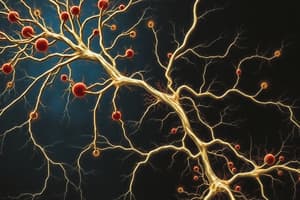Podcast
Questions and Answers
O sistema nervoso é composto por células especializadas chamadas ______.
O sistema nervoso é composto por células especializadas chamadas ______.
neurônios
O sistema nervoso central (SNC) é formado pelo ______ e pela medula espinhal.
O sistema nervoso central (SNC) é formado pelo ______ e pela medula espinhal.
cérebro
O sistema nervoso autônomo regula funções involuntárias, como ______, digestão e respiração.
O sistema nervoso autônomo regula funções involuntárias, como ______, digestão e respiração.
frequência cardíaca
Os ______ são células de suporte do sistema nervoso.
Os ______ são células de suporte do sistema nervoso.
Os ______ transmitem sinais químicos entre os neurônios durante a comunicação.
Os ______ transmitem sinais químicos entre os neurônios durante a comunicação.
As células gliais fornecem suporte, isolamento e nutrição para os ______.
As células gliais fornecem suporte, isolamento e nutrição para os ______.
A ______ é responsável por relatar mensagens entre o cérebro e o resto do corpo.
A ______ é responsável por relatar mensagens entre o cérebro e o resto do corpo.
O ______ é responsável por funções cognitivas superiores, como pensar, aprender e lembrar.
O ______ é responsável por funções cognitivas superiores, como pensar, aprender e lembrar.
O sistema nervoso se desenvolve a partir de uma estrutura embrionária ______.
O sistema nervoso se desenvolve a partir de uma estrutura embrionária ______.
Doenças neurológicas, como a ______ e a doença de Alzheimer, podem afetar o sistema nervoso.
Doenças neurológicas, como a ______ e a doença de Alzheimer, podem afetar o sistema nervoso.
Flashcards
Sistema Nervoso Central (SNC)
Sistema Nervoso Central (SNC)
O cérebro e a medula espinhal que processam informações e controlam funções corporais.
Sistema Nervoso Periférico (SNP)
Sistema Nervoso Periférico (SNP)
Rede de nervos que conectam o SNC ao resto do corpo.
Sistema Nervoso Somático
Sistema Nervoso Somático
Controla movimentos voluntários dos músculos esqueléticos.
Sistema Nervoso Autônomo
Sistema Nervoso Autônomo
Signup and view all the flashcards
Sistema Nervoso Simpático
Sistema Nervoso Simpático
Signup and view all the flashcards
Sistema Nervoso Parassimpático
Sistema Nervoso Parassimpático
Signup and view all the flashcards
Tipos de células no cérebro
Tipos de células no cérebro
Signup and view all the flashcards
Neurônios
Neurônios
Signup and view all the flashcards
Neurotransmissores
Neurotransmissores
Signup and view all the flashcards
Função da medula espinhal
Função da medula espinhal
Signup and view all the flashcards
Receptores Sensoriais
Receptores Sensoriais
Signup and view all the flashcards
Especialização cerebral
Especialização cerebral
Signup and view all the flashcards
Integração cerebral
Integração cerebral
Signup and view all the flashcards
Células Gliais
Células Gliais
Signup and view all the flashcards
Desenvolvimento do Sistema Nervoso
Desenvolvimento do Sistema Nervoso
Signup and view all the flashcards
Doenças Neurológicas
Doenças Neurológicas
Signup and view all the flashcards
Study Notes
General Overview
- The nervous system is a complex network of specialized cells, neurons, that transmit information throughout the body.
- It's responsible for coordinating actions, processing sensory information, and regulating bodily functions.
- Two major divisions: the central nervous system (CNS) and the peripheral nervous system (PNS).
Central Nervous System (CNS)
- Composed of the brain and spinal cord.
- The brain serves as the control center for thoughts, emotions, memory, and voluntary actions.
- Subdivisions include cerebrum, cerebellum, and brainstem.
- The spinal cord transmits information between the brain and the rest of the body.
- Acts as a pathway for reflexes and other involuntary responses.
- Protected by the skull and vertebrae.
Peripheral Nervous System (PNS)
- Connects the CNS to the rest of the body.
- Composed of nerves that extend from the brain and spinal cord to various organs and tissues.
- Divided into the somatic and autonomic nervous systems.
Somatic Nervous System
- Controls voluntary movements of skeletal muscles.
- Sensory neurons transmit information about touch, temperature, and pain to the CNS.
- Motor neurons carry signals from the CNS to the muscles, initiating movement.
Autonomic Nervous System
- Controls involuntary functions, such as heart rate, digestion, and breathing.
- Further divided into sympathetic and parasympathetic divisions.
Sympathetic Nervous System
- Activated during stress or excitement.
- "Fight-or-flight" response.
- Increases heart rate, blood pressure, and breathing rate.
- Dilates pupils.
Parasympathetic Nervous System
- Activated during relaxation or rest.
- "Rest-and-digest" response.
- Decreases heart rate, blood pressure, and breathing rate.
- Constricts pupils.
Neurons
- Basic functional units of the nervous system.
- Contain a cell body, dendrites, and an axon.
- Dendrites receive signals, axons transmit signals.
- Communicate with each other through synapses, releasing neurotransmitters.
Neurotransmitters
- Chemical messengers that transmit signals across synapses.
- Examples include dopamine, serotonin, acetylcholine, and norepinephrine.
- Different neurotransmitters have different effects on the body.
Sensory Receptors
- Specialized cells that detect stimuli from the environment or within the body.
- Different types of receptors exist for different sensations, such as touch, light, sound, and taste.
Glial Cells
- Supporting cells of the nervous system.
- Provide support, insulation, and nourishment for neurons.
- Outnumber neurons in the brain.
Spinal Cord
- Important for relaying messages between the brain and the rest of the body.
- Contains tracts of nerve fibers that transmit sensory and motor information.
- Involved in simple reflexes.
Brain Structure
- Different regions of the brain perform specialized functions.
- Cerebrum is responsible for higher cognitive functions, like thinking, learning, and memory.
- Cerebellum coordinates movement and balance.
Brain Function
- The brain integrates information from various sources, leading to thoughts, emotions, and actions.
- Different regions are responsible for different processes across brain functions.
Development
- The nervous system develops from an early embryonic structure.
- Neurons develop and migrate to their designated locations.
- Connections between neurons form throughout life and are modified by experience.
Disorders
- Various neurological disorders can affect the nervous system.
- Examples include Parkinson's disease, Alzheimer's disease, multiple sclerosis, and stroke.
Studying That Suits You
Use AI to generate personalized quizzes and flashcards to suit your learning preferences.




